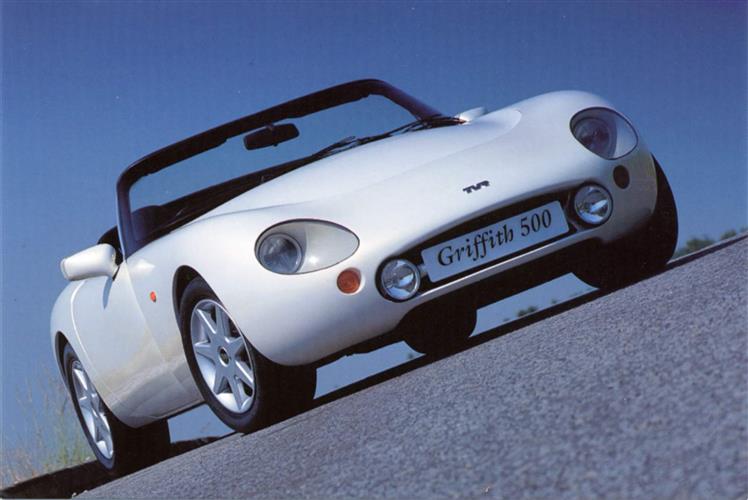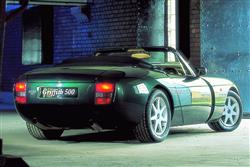THE POWER AND THE GLORY (some text hidden) --NONE--
BY ANDY ENRIGHT
Introductionword count: 136
The TVR Griffith was the car that pushed TVR into the big league of performance car manufacturers when it was unveiled in 1990. The wedge-shaped cars of the eighties were nearing the limits of their development and a new direction needed to be found. The Griffith embodied all of the innovation, design flair and sheer bloody-mindedness that TVR has come to stand for. Ferociously quick and hairy of chest, the Griffith is a car that doesn't suffer fools gladly. Although TVR boss Peter Wheeler won't thank us for reminding him, TVRs of the early nineties had a mixed reputation for reliability, but there are legions of Griffith owners who can attest to miles of trouble-free motoring. As long as you choose carefully and budget extra time and money for upkeep, you shouldn't go too far wrong.
Modelsword count: 9
Models Covered: (2 dr roadster 4.0, 4.3, 5.0 petrol)
Historyword count: 402
At the end of the eighties, TVR found itself with two product lines, the wedge-shaped Tasmin-based cars and the newer, but retro-styled 'S' models. As tastes changed, the wedge shaped cars were starting to date badly, and the more rounded 'S' models were starting to outsell them. TVR unveiled the Griffith at the 1990 British Motor Show, with a 4-litre version of Rover's trusty V8 engine mounted on a strengthened TVR 'S' chassis. Public reaction was encouraging with over 300 orders being placed for the new car. The only problem was that even in this form, the 'S' chassis was only ever going to be able to handle around 270bhp, so TVR had to go back to the drawing board and use a shortened chassis from the Tuscan racer, a car which produced well in excess of 400bhp. With TVR now content with the basic foundation of the car, some styling modifications were made and the first cars were delivered to happy owners in early 1992. Demand for the Griffith dictated that over 70% of the Blackpool factory's production capacity was instantly devoted to Griffith construction, the fact that the Griffith 4.0 was over £2,500 cheaper than the outgoing 400SE 'wedge' effectively sounding the death knell for the older car. For about the price of a 400SE, customers could order the Griffith 4.3, again using the Rover V8 but this time with a bored and tuned version which developed 280bhp. Over seventy percent of Griffith customers opted for the larger engined car. Production of UK Griffiths was temporarily suspended in November 1992 to allow the factory to clear the foreign orders backlog and ramp up production of the new Chimaera model line. In 1993, TVR launched the Griffith 500. Originally due to use the AJP8 engine of TVR's own design, the Griffith again relied on the Rover V8, due in no small part to the development of the AJP8 falling behind schedule. The car received a facelift with driving lamps mounted low in the front air intake, and OZ wheels were fitted as standard. AT the same time tyre sizes, spring rates and shock absorber settings were adjusted across the range to calm the rear suspension's inherent jitteriness. The 4.0 and 4.3-litre cars were axed in 1993, leaving the Griffith 500 the sole model carrying the flag. With the arrival of the Tuscan Speed Six in 1999, the Griffith's days look numbered.
What You Getword count: 314
Seat yourself behind the grippy little sports steering wheel and you know you're in the cockpit of a car that means business. A twist of the ignition key brings further enlightenment; exercising the big V8 will not be a task for the faint-hearted. Be in no doubt, a TVR Griffith isn't really much good as an only car. Nor is it meant to be. This is a two-seater only of course and the boot space is tiny. So buy yourself a day-to-day car and store it in a covered, dry place like a fine-wine to enjoy whenever the mood takes you. If you're affluent enough to be able to do that, then you're fortunate indeed. After all, much of the enjoyment of owning a Griffith 500 can be gained without even gunning the engine into life. The gorgeous shape is pure automotive sculpture, the sweeping lines complemented on later models by a tasty set of OZ seven-spoke alloy wheels. Inside, set amongst the walnut and leather, the gearknob and some of the switches are fashioned out of alloy (though there are no graphics on them to explain what they actually do). Apart from this, the choice is yours. One of the great attractions of a TVR has always been the way that the finished car can be trimmed exactly to the individual customer's taste. Before you take delivery, you`ll be offered a mind-boggling array of interior trim and exterior colour choices so that the car can be built just as you want it. In fact, so wide is the selection on offer that TVR say the chance of two identical cars ever leaving the factory is remote in the extreme. The fascia isn't as barmy in its design as the Cerbera or Tuscan models, but some buyers will consider this a plus. As a true throwback English sports car, the Griffith has few peers.
To see the full road test text contact us on 0330 0020 227
Pictures (high res disabled)


|
Scoring (subset of scores)
Category: Sporting Cars
| Performance | |
| Handling | |
| Comfort | |
| Space | |
| Styling, Build, Value, Equipment, Depreciation, Handling, Insurance and Total scores are available with our full data feed. | |



